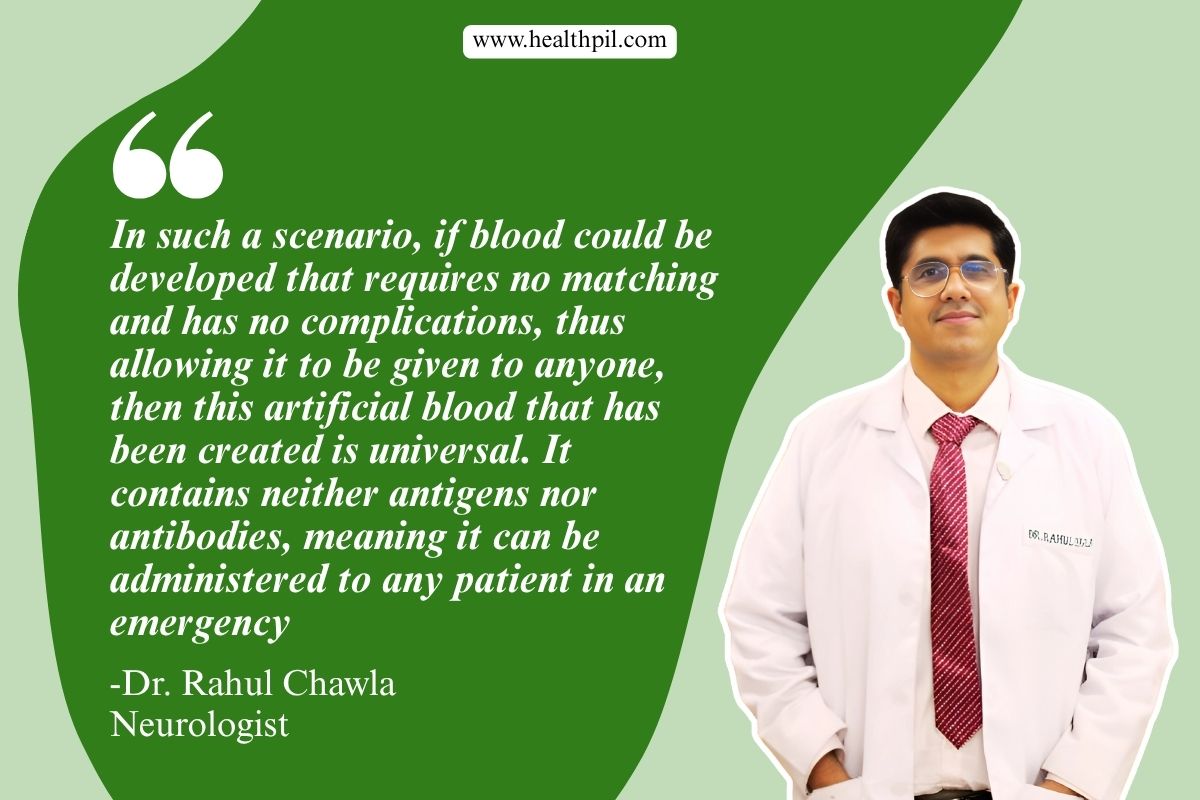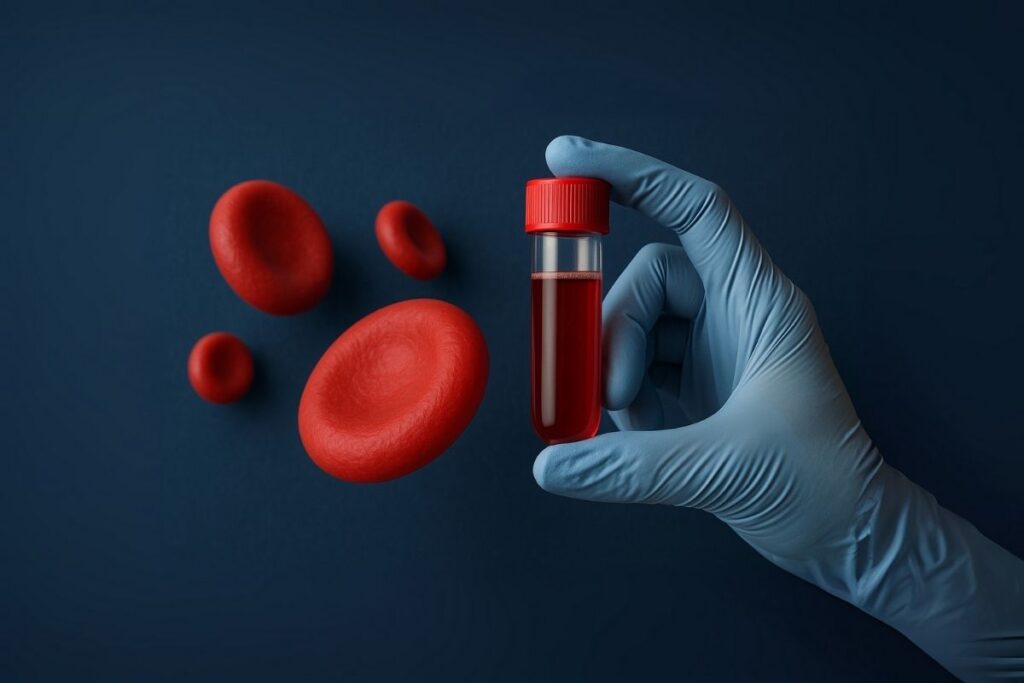Imagine being in a road accident, losing blood rapidly, and needing an urgent transfusion. But there’s no time to check your blood group, and the right donor blood isn’t always available. That delay could prove to be fatal.
Now, imagine a scenario where doctors can give you any blood without needing to know your blood type and it works perfectly without any delay or risk of mismatch and almost no chance of infection. That’s exactly the vision behind Japan’s groundbreaking artificial blood, currently in advanced stages of clinical trials.
What Makes This Artificial Blood So Special?
Researchers at Nara Medical University in Japan, led by Prof. Hiromi Sakai, have developed a new kind of synthetic blood with some revolutionary features:
Universal Compatibility
This artificial blood can be given to anyone, regardless of whether their blood group is A, B, AB, or O. It has no antigens or antibodies, making it truly universal.
In a recent conversation with Zee News, Dr. Rahul Chawla explained:

“In such a scenario, if blood could be developed that requires no matching and has no complications, thus allowing it to be given to anyone, then this artificial blood that has been created is universal. It contains neither antigens nor antibodies, meaning it can be administered to any patient in an emergency.”
This kind of universal blood could save precious minutes during emergencies like trauma, stroke, or postpartum hemorrhage
Long Shelf Life, Easy Storage
While traditional donated blood lasts about 42 days and needs refrigeration, this artificial blood can be stored for two years at room temperature, or up to five years if refrigerated, making it ideal for disaster zones, ambulances, rural clinics, or military deployments where cold-chain storage is a major challenge.
Virus-Free and Safer
Since it’s created from purified components, there’s no risk of virus transmission like HIV or Hepatitis B, something that can still be a concern in traditional blood transfusion, especially in settings with limited resources. The product is also free of immune triggers, making adverse reactions far less likely.
The World Health Organization has long raised concerns about the global shortage of safe blood, especially in low- and middle-income countries. In many parts of the world, patients in trauma, surgery, childbirth, or cancer care die simply because compatible blood isn’t available on time.
Japan itself faces a shrinking donor base due to its aging population. This artificial blood could provide a reliable, on-demand supply, independent of how many people are donating.
If everything goes as planned, this invention could change how the world looks at blood transfusion entirely.
#DNAWithRahulSinha | अब ब्लड की कमी से किसी की जान नहीं जाएगी! देखिए, जापान में बना ‘आर्टिफिशियल ब्लड’ का विश्लेषण#DNA #Japan #Blood #ArtificialBlood@RahulSinhaTV pic.twitter.com/nueVfUIzWh
— Zee News (@ZeeNews) July 3, 2025
How Does This Artificial Blood Work?
● The core ingredient is hemoglobin, the protein in red blood cells that carries oxygen. This is extracted from expired donated blood.
● The hemoglobin is then encased in fat-based bubbles (lipid vesicles), designed to float through the bloodstream like red blood cells do, without triggering the body’s immune system.
● This processed form of blood has a purplish color, due to the nature of purified hemoglobin.
● It behaves much like natural blood, delivering oxygen where it’s needed in the body.
● A parallel approach by Prof. Teruyuki Komatsu of Chuo University involves enclosing hemoglobin in albumin-based shells, showing early success in animal trials for shock, stroke, and hemorrhage treatment.
What Stage Are the Trials In?
● Early clinical trials have been conducted safely in healthy volunteers, with no serious side effects.
● By March 2025, larger trials are expected to begin at Nara Medical University, involving adults receiving doses between 100 and 400 mL.
● If results remain positive, Japan aims to introduce artificial blood in hospitals by 2030, possibly becoming the first country in the world to do so.
Why Is This An Important Breakthrough?
In natural disasters, war zones, or developing regions where access to donor blood is limited, a stable, shelf-storable, universal alternative can save thousands of lives. It also removes the logistical and ethical implications around human donors.
In a world where maternal deaths due to postpartum hemorrhage and road traffic trauma remain leading causes of preventable mortality, this could be a game-changer.
FAQs
What is artificial blood made of?
It’s based on purified hemoglobin, the protein that carries oxygen in real blood. This is enclosed in fat-based or albumin-based shells to make it safe for circulation.
Can it replace regular donated blood?
Not entirely—for now, it mainly helps in oxygen transport. It does not replace other components like platelets or clotting factors. But it’s immensely helpful in emergency situations.
Is it safe?
Early trials have shown no major side effects, and the artificial blood is virus-free. It’s designed to be less likely to cause allergic or immune reactions.
Who will benefit most from this?
● Trauma and accident victims
● Patients in rural or remote locations
● War zones and military personnel
● Hospitals facing blood shortages
When will it be available?
If trials continue to be successful, deployment in Japan could begin by 2030. Global rollout will depend on further approvals and production scaling. While we still have a few years before this product becomes widely available, the concept of artificial blood brings hope to the field of medicine and it might just help create a more equitable, efficient, and safer emergency care system.
HealthPil Supports Blood Health Awareness
At HealthPil, we believe that innovations in medicine, like this, deserve public awareness. Whether it’s real-time updates on global health breakthroughs or connecting you with top doctors for blood-related conditions like anemia or clotting disorders, we’re here to help.
● Book a specialist consult on hematology or transfusion medicine
● Read expert blogs and research-backed guidance
● Learn how you can contribute to safer health systems
Disclaimer
This article is for general informational purposes only. The artificial blood mentioned is still under clinical trials and not yet in routine medical use. Always consult your healthcare provider for decisions regarding transfusions or critical care.

